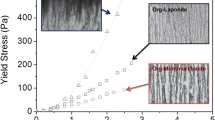Abstract
A systematic study of the influence of salinity and clay content on the electrical conductivity of sodium-illite clay gels shows that the geometry or “formation resistivity factors” of such systems can adequately be described by the model of oblate ellipsoids, used to simulate the shape of the clay particles. This conclusion is in agreement with the results previously obtained on kaolinite and montmorillonite clays. An axial ratio of 16 was found for the illite clay particles.
On the basis of Burger’s and Maxwell’s equations for electric flow through porous media, formulae are derived for calculating the electrical conductivity of mixed systems, i.e. “clay 1 + clay 2 + electrolyte solution” and “clay + spherical particles + electrolyte solution”. The electrical conductivity of these systems is expressed in terms of the shape parameters, surface conductances, specific surfaces and volume concentrations of the constituents. The type of equation can eventually lead to an explanation (in terms of a non-uniform particle shape distribution) of the anomalous geometry effects in some clays.
Experimental results conform fairly well to the equations. Glass powder at volume fraction between 0.18 and 0.60 added to a 17.4% montmorillonite gel acts as an inert diluent on the specific electrical conductivity of the mixture. For a mixture of 1 part montmorillonite to 9 parts kaolinite, the measured specific electrical conductivity agrees within about 10% with the predicted over the range studied (volume fraction of montmorillonite: 0.035 to 0.039; mixture porosity: 0.61 to 0.660; salt concentration range: 0.5 n to 2 n NaCl).
Similar content being viewed by others
References
Anderson, D. M., and Low, P. F. (1958) The density of water adsorbed by lithium, sodium and potassium bentonite, Proc. Soil Sci. Soc. Amer. 22, 99–103.
Archie, G. E. (1942) The electrical conductivity log as an aid in determining some reservoir characteristics, Trans. A.I.M.E. 146, 55–62.
Bloksma, A. H. (1957) The diffusion of sodium and iodide ions and urea in clay pastes, Jour. Coll. Sci. 12, 40–52.
Böttcher, C. J. F. (1945) The dielectric constant of crystalline powders, Rec. Trav. Chim. Pays Bas. 64, 47–51.
Bruggeman, D. A. G. (1935) The calculation of various physical constants of heterogeneous substances. I. The dielectric constants and conductivities of mixtures composed of isotropic substances, Ann. Physik. 24, 636–64.
Burger, H. C (1919) Das Leitvermogen verdunnter mischkristallfreien Legierungen, Phys. Zeits. 20, 73–5.
Clark, N. O. (1948) Electrical conductivity of foam, Trans. Faraday Soc. 44, 13–15.
Cremers, A., and Latjdelotjt, H. (1965a) Conductivité électrique des gels argileux et anisométrie de leurs éléments, Jour. Chim. Phys. 62, 1155–62.
Cremers, A., and Latjdelotjt, H. (19656) On the “Isoconductivity value” of clay gels, Soil Sci. 100, 298–9.
Dakshinamtjrti, S. (1960) Studies on the conductivity of clay systems, Soil Sci. 90, 302–5.
Dutt, G. R., and Low, P. F. (1961) Relationship between the activation energy for deuterium oxide diffusion and exchangeable ion conductance in clay systems, Soil Sci. 93, 195–203.
Fricke, H. (1924) A mathematical treatment of the electrical conductivity and capacity of disperse systems, Phys. Rev. 24, 575–87.
Glasstone, S., Laidler, K. J., and Eyring, H. (1941) The Theory of Rate Processes, McGraw-Hill, New York.
Lai, T. M., and Mortland, M. M. (1961) Diffusion of ions in bentonite and vermiculite, Proc. Soil Sci. Soc. Amer. 25, 353–7.
Lai, T. M., and Mortland, M. M. (1962) Self-diffusion of exchangeable cations in bentonite, Clays and Clay Minerals, Proc. 9th Conf., Pergamon Press, New York, 229–47.
Leonard, R. A., and Low, P. F. (1964) Effect of salt on water movement in soils, Presented at meeting of Amer. Soc. Agronomy in Kansas City.
Low, P. F. (1962) Influence of adsorbed water on exchangeable ion movement, Clays and Clay Minerals, Proc. 9th Conf., Pergamon Press, New York, 219–28.
Low, P. F. (1958) The apparent mobilities of exchangeable alkali metal cations in bentonite water systems, Proc. Soil Sci. Soc. Amer. 22, 395–8.
Martin, H., and Laudelout, H. (1963) Thermodynamique de l’echange des cations alcalins dans les argiles, Jour. Chim. Phys. 60, 1086–99.
Maxwell, S (1887) A Treatise on Electricity and Magnetism, 2nd ed. vol. I, 435, Clarendon Press, Oxford.
Meredith, R. E. (1959) Studies on the conductivities of dispersions, Lawrence Radiation Laboratory Report, U.C.R.L.—8667.
Meredith, R. E., and Tobias, C. W. (1962) Conduction in heterogeneous systems, Adv. Electr. and Electrochem. Engr. 2, 15–47.
Patnode, H. W., and Wyllie, M. R. J. (1950) The presence of conductive solids in reservoir rocks as a factor in electric log interpretation, Trans. A.I.M.E. 189, 47–52.
Penman, H. L. (1940a) Gas and vapor movements in the soil. I. The diffusion of vapours through porous solids, Jour. Agr. Sci. 30, 437–62.
Penman, H. L. (1940b) Gas and vapor movements in the soil. II. The diffusion of carbondioxide through porous solids, Jour. Agr. Sci. 30, 570–81.
Street, N. (1956a) Effect of surface conductance on drilling mud resistivity, Bull. Amer. Assoc. Petrol Geol. 40, 1996–2000.
Street, N. (1956b) The surface conductance of kaolinite, Australian Jour. Chem. 9, 333–46.
Street, N. (1963) On “the Isoconductivity value” of clays, Soil Sci. 95, 367.
Wyllie, M. R. J., and Southwick, P. P. (1954) An experimental investigation on the S.P. and resistivity phenomena in dirty sands, Trans. A.I.M.E. 201, 43–56.
Author information
Authors and Affiliations
Rights and permissions
About this article
Cite this article
Cremers, A., van Loon, J. & Laudelout, H. Geometry Effects for Specific Electrical Conductance in Clays and Soils. Clays Clay Miner. 14, 149–162 (1966). https://doi.org/10.1346/CCMN.1966.0140113
Published:
Issue Date:
DOI: https://doi.org/10.1346/CCMN.1966.0140113



